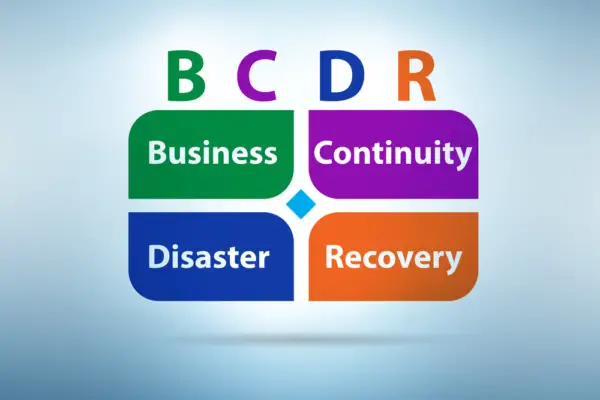In the dynamic landscape of modern business, the importance of a robust Business Continuity Plan (BCP) cannot be overstated.
As enterprises navigate an ever-evolving array of risks—from natural disasters to cyber-attacks—they need a well-crafted and regularly tested BCP to ensure organizational resilience and operational continuity.
But a key question often arises: “How often should a Business Continuity Plan be tested?”
This question is not just about compliance or ticking a box; it’s about ensuring that your plan is effective, current, and capable of guiding your organization through unforeseen challenges.
In this blog post, we delve into the intricacies of BCP testing frequency, exploring factors that dictate the timing and the impact of regular testing on an organization’s readiness to face disruptions.
We aim to provide insights that help businesses survive and thrive in the face of adversity, understanding that the frequency of BCP testing is a crucial component of this journey.
A well-crafted Business Continuity Plan (BCP) is a roadmap for organizations to mitigate risks and prepare for unforeseen disruptions.
However, the effectiveness of a BCP lies in its regular testing. This article will explore the crucial question: How often should a business continuity plan be tested?
Organizations can enhance resilience by understanding test frequency and types to safeguard their operations.

What is a Business Continuity Plan?
A business continuity plan is a comprehensive strategy that outlines the necessary steps and procedures to ensure the continued operation and resilience of a business in the face of disruptive events or incidents.
It is a crucial aspect of business continuity planning, as it helps mitigate the risks associated with potential disruptions and ensures the smooth functioning of business operations.
Regular business continuity plan testing is essential to evaluate its effectiveness and identify gaps or areas for improvement.
This testing process involves conducting tests on various aspects of the plan, such as communication processes, resource allocation, and recovery procedures.
The results of these tests are then reviewed to determine if any adjustments or enhancements are needed to strengthen the plan’s ability to protect the business and its operations.
2. Benefits of Regular Testing
Regular testing of a business continuity plan offers numerous benefits. It allows organizations to assess the plan’s effectiveness and make necessary improvements to ensure the continued operation and resilience of the business.
The benefits of regular testing can be summarized as follows:
- Identifying weaknesses: Regular tests allow identifying any weaknesses or gaps in the business continuity plan. By simulating potential business disruptions, organizations can uncover areas that need improvement and take necessary actions to address them.
- Evaluating potential risks: Through regular testing, organizations can evaluate potential risks and their potential impact on the business. This allows them to understand the vulnerabilities better and develop effective strategies to mitigate those risks.
- Ensuring readiness: Regular testing ensures the organization is prepared to respond to potential disruptions. Organizations can ensure that their strategies and procedures are up-to-date and aligned with current best practices by conducting frequent reviews and updates to the business continuity plan.
3. How Often Should a Business Continuity Plan Be Tested?
To maintain the effectiveness and resilience of a business continuity plan, it is important to test its capabilities and response strategies regularly.
Testing is a critical component of the business continuity plan review process and ensures that the plan remains up-to-date and aligned with the organization’s evolving needs.
The testing frequency depends on various factors, including the organization’s size, industry regulations, and the level of risk it faces.
Business continuity testing can range from smaller-scale exercises, such as tabletop simulations, to larger-scale exercises, such as full-scale exercises involving multiple departments and external stakeholders.
It is generally recommended to conduct testing at least once a year, following a structured testing lifecycle that includes planning, executing, evaluating, and updating the test results.
Regular testing, combined with an annual review, helps organizations identify gaps, improve response strategies, and enhance the overall effectiveness of their business continuity plans.
4. Types of Tests to Consider
When considering the types of tests to include in a business continuity plan, it is important to focus on relevant and realistic scenarios.
One type of test to consider is natural disaster scenarios, such as earthquakes or hurricanes, to ensure the plan can effectively address these potential disruptions.
Another type of test to consider is unexpected event scenarios, such as power outages or cyber attacks, to evaluate the plan’s ability to respond to unforeseen circumstances.
Natural Disaster Scenarios
Simulating natural disaster scenarios is one effective approach to testing a business continuity plan.
This type of testing helps organizations evaluate their preparedness and response processes in the face of potential incidents caused by natural disasters.
Businesses can simplify natural disaster testing by breaking the process down into sub-lists.
- Types of natural disasters: This include hurricanes, earthquakes, floods, wildfires, and severe storms.
- Location-specific threats: Businesses should consider the specific natural disasters that are most likely to occur in their geographic location.
- Allocation of resources: Testing should assess the availability and adequacy of resources such as backup power, communication systems, and emergency supplies.
Businesses can improve their readiness for natural disasters by testing their business continuity plans against various scenarios.
Incorporating these tests into a regular review schedule is important to maintain the plan’s effectiveness.
Unexpected Event Scenarios
Testing a business continuity plan should also include simulations of unexpected event scenarios to ensure preparedness and effectiveness.
These scenarios go beyond natural disasters and encompass various disruptive events that can impact business operations.
To conduct effective testing, organizations should consider performing a business impact analysis to identify potential risks and vulnerabilities.
This analysis will inform the development of a comprehensive business continuity strategy and implementing a business continuity management system.
Tests such as business continuity drills and incident response exercises can help evaluate the effectiveness of crisis management plans and incident response procedures.
5. Important Details to Remember When Testing Your BCP
During the testing phase of a business continuity plan, it is essential to pay close attention to the important details that need to be remembered.
To ensure the effectiveness of BCP testing processes and the overall resilience of business continuity management systems, several key factors should be considered:
- Conduct annual tests: Regular testing helps identify potential weaknesses and allows for necessary adjustments to be made in a timely manner.
- Update business impact analysis: As business risks may change over time, it is crucial to regularly review and update the business impact analysis to ensure it accurately reflects the current environment.
- Test the disaster recovery plan: Testing the disaster recovery plan is vital to confirm that critical systems can be restored within the required timeframes.
- Validate redundant systems: Verifying the functionality of redundant systems ensures that backup infrastructure is functioning properly and can be relied upon in the event of a disruption.
6. The Importance of Documentation and Reviews
Proper documentation and regular reviews are essential to ensure the effectiveness and reliability of a business continuity plan.
Documentation plays a critical role in the business continuity lifecycle, as it provides a comprehensive record of the plan’s objectives, strategies, and procedures.
It also helps in business continuity plan maintenance by documenting any updates or changes made to the plan over time.
Regular reviews conducted by business continuity professionals or the business continuity response team are necessary to identify any gaps or weaknesses in the plan and to ensure that it remains aligned with the organization’s evolving needs and priorities.
These reviews may involve business continuity risk assessments, evaluation of business continuity solutions and tools, and analysis of any business continuity issues that may have occurred.
7. Key Personnel for Developing and Implementing the BCP
As part of the business continuity plan’s development and implementation process, identifying key personnel who will be responsible for its execution is crucial.
These individuals play a vital role in ensuring the effectiveness of the plan and its ability to mitigate potential disruptions.
When developing and implementing a BCP, business entities should consider the following key personnel:
- Business Assurance Team: These individuals assess the organization’s risk profile and identify potential threats. They play a crucial role in developing the BCP by analyzing the impact of various scenarios and defining the strategies to address them.
- Business Consultants: Engaging experienced business consultants can provide valuable insights and expertise in developing a comprehensive BCP. These professionals can guide organizations in identifying critical business functions, conducting risk assessments, and implementing effective mitigation strategies.
- Business Continuity and Disaster Recovery Planning Team: This team is responsible for the BCP’s development, implementation, and testing. They coordinate efforts across different departments and ensure that the plan aligns with the organization’s objectives and complies with industry standards.
8. Business Impact Analysis (BIA) and Risk Assessment
To ensure the effectiveness of a business continuity plan, it is essential to conduct regular Business Impact Analysis (BIA) and Risk Assessments.
A business impact analysis is a process that identifies and evaluates the potential impact of disruptive events on an organization’s operations.
It helps identify critical business functions, dependencies, and disruptions’ potential financial and operational impacts.
On the other hand, risk assessment identifies and analyzes potential threats and vulnerabilities to an organization’s assets, such as personnel, facilities, and IT systems.
Organizations can identify potential disruptions and develop strategies to mitigate their impact by conducting BIA and risk assessments.
Regular business continuity plan testing, including disaster recovery exercises and emergency response drills, is crucial to ensure its effectiveness in real-world situations.

9. Designing a Testing Schedule
A well-designed testing schedule is essential for ensuring the effectiveness of a business continuity plan.
To create an effective testing schedule, businesses should consider the following:
- Frequency: Regular testing is crucial to identify and address any gaps or weaknesses in the plan. It is recommended to conduct annual emergency drills to assess the readiness of the business continuity management.
- Types of Tests: Different tests should be incorporated into the schedule. This includes walk-through tests, which simulate potential threats and allow the crisis management team to evaluate the plan’s response. Additionally, conducting tests based on real incidents and disaster recovery scenarios can help validate the recovery strategies.
- Documentation: Documenting the results and lessons learned from each test is important. This will enable businesses to refine and improve their business continuity plan, ensuring its effectiveness in a real-life crisis situation.
10. Establishing Clear Objectives for Each Test
The establishment of clear objectives for each test is crucial in ensuring the effectiveness of a business continuity plan.
Testing business continuity plans helps organizations identify gaps and weaknesses in their plans, allowing them to make necessary improvements.
Organizations can measure the effectiveness of their testing efforts by establishing clear objectives.
To illustrate the importance of clear objectives, the following table outlines different types of tests and their corresponding objectives:
| Test Type | Objective |
|---|---|
| Limited-Scale Exercise | Assess the effectiveness of specific procedures and identify areas for improvement |
| Desktop Exercise | Evaluate the plan’s functionality and validate the effectiveness of communication channels |
| Actual Exercise | Test the plan’s ability to be executed in a real-life scenario and identify any deficiencies |
| Annual Tabletop Exercise | Validate incident management and critical processes, test decision-making capabilities, and identify areas for improvement |
Establishing clear objectives for each test allows organizations to focus their efforts, measure the plan’s effectiveness, and identify areas for improvement.
This helps ensure that the business continuity plan is robust and capable of effectively responding to any disruptions or incidents.
11. Conducting Full-Scale Exercises
Conducting full-scale exercises is critical to testing a business continuity plan and ensuring its effectiveness in responding to disruptions or incidents.
These exercises simulate real-life scenarios and provide an opportunity to evaluate the readiness of the business continuity team to handle unexpected events.
During these exercises, the business continuity team follows a predefined schedule and simulates the impact of an event on normal operations.
They assess the alignment of their actions with the business objectives and evaluate the effectiveness of their crisis response team.
Furthermore, the exercises involve creating scenarios for threats that could potentially disrupt the organization’s operations.
This allows the leadership to assess their response and identify any gaps in the business recovery plan.
Full-scale exercises provide valuable insights into the strengths and weaknesses of the plan, enabling the organization to make necessary improvements and enhance its overall resilience.
12. Documenting the Results of Tests and Reviews
To ensure accountability and track progress, it is essential to document the results of tests and reviews conducted on the business continuity plan.
Organizations can obtain insights and identify areas for improvement by documenting results for future testing and review cycles.
One effective way to document the results is through the use of a table. The table below provides an example format for documenting the results of tests and reviews:
| Test/Review | Date | Findings | Recommendations | Action Taken |
|---|---|---|---|---|
| Full-scale exercise | 10/15/2022 | Identified gaps in communication procedures during a simulated business disruption. | Develop and implement a communication plan to address identified gaps. | Communication plan developed and implemented on 11/1/2022. |
In addition to documenting the findings, it is important to include recommendations for improvement and any actions taken to address the identified issues.
This helps ensure the business continuity plan evolves and adapts to the changing business landscape and technology standards.
Regular testing and documentation of results are crucial for maintaining a robust and effective business continuity plan.
13. Review Process and Evaluation of Test Results
The review process and evaluation of test results is an integral part of ensuring the effectiveness of a business continuity plan.
It allows organizations to assess the strengths and weaknesses of their emergency preparedness plans and make necessary improvements.
When conducting a review, an insurance company, for example, might consider the performance of critical personnel during a simulated disaster scenario.
They could evaluate the resilience of their supply chain, particularly if it is complex and spans multiple locations.
Additionally, they might assess the effectiveness of their pandemic preparedness and recovery protocols.
Frequently Asked Questions
What Are the Consequences of Not Regularly Testing a Business Continuity Plan?
The consequences of not regularly testing a business continuity plan can be severe, including potential operational disruptions, financial losses, damage to reputation, and inability to recover from a crisis effectively.
Regular testing ensures readiness and identifies areas for improvement.
How Can a Business Determine the Appropriate Frequency for Testing its Continuity Plan?
The appropriate frequency for testing a business continuity plan can be determined by considering various factors such as the criticality of the business operations, industry regulations, changes in the business environment, and lessons learned from previous tests or real incidents.
Are Any Industry-Specific Regulations or Standards That Dictate the Testing Frequency for Business Continuity Plans?
Some several industry-specific regulations and standards dictate the testing frequency for business continuity plans.
These regulations ensure that businesses are adequately prepared for potential disruptions and can effectively recover in a timely manner.
What Factors Should Be Considered When Designing a Testing Schedule for a Business Continuity Plan?
When designing a testing schedule for a business continuity plan, it is important to consider factors such as the criticality of the business functions, changes in technology or infrastructure, regulatory requirements, and lessons learned from previous tests or real incidents.
How Can Businesses Ensure That the Results of Tests and Reviews Are Effectively Utilized to Improve Their Continuity Plan?
To ensure that the results of tests and reviews effectively improve a business continuity plan, businesses can establish a clear process for analyzing and implementing the findings, regularly communicate with stakeholders, and regularly update and revise the plan as needed.

Conclusion
Regularly testing a business continuity plan ensures its effectiveness and success.
Businesses can identify weaknesses or gaps in their plan by establishing clear objectives, conducting various tests and full-scale exercises and documenting the results.
The review process and evaluation of test results further enhance the plan’s efficacy.
Frequent testing is essential for maintaining a robust business continuity plan.

Chris Ekai is a Risk Management expert with over 10 years of experience in the field. He has a Master’s(MSc) degree in Risk Management from University of Portsmouth and is a CPA and Finance professional. He currently works as a Content Manager at Risk Publishing, writing about Enterprise Risk Management, Business Continuity Management and Project Management.

